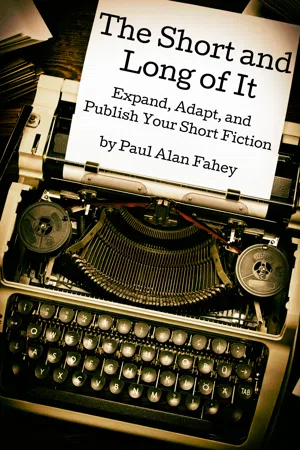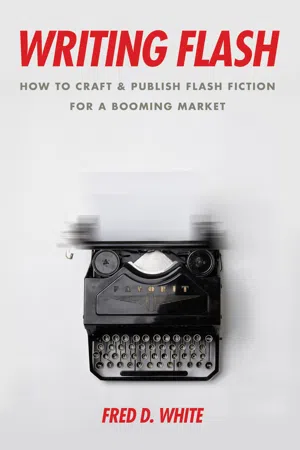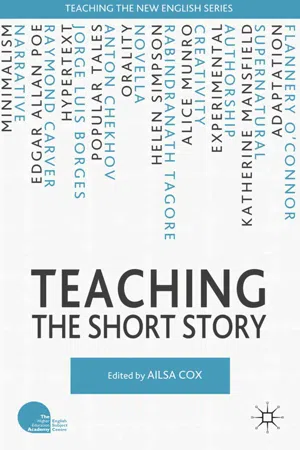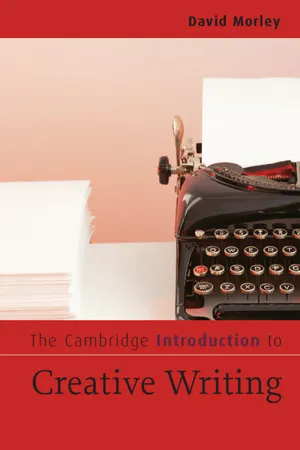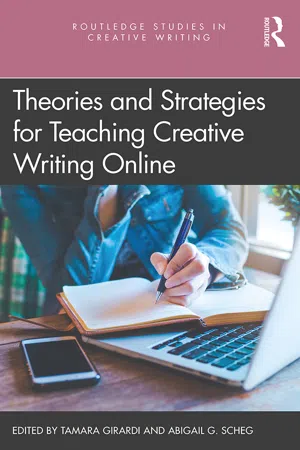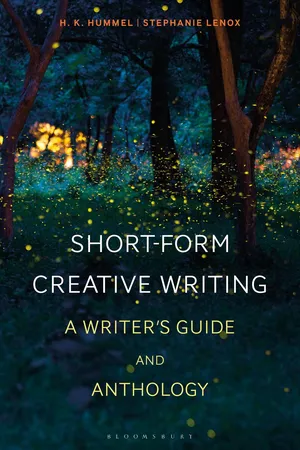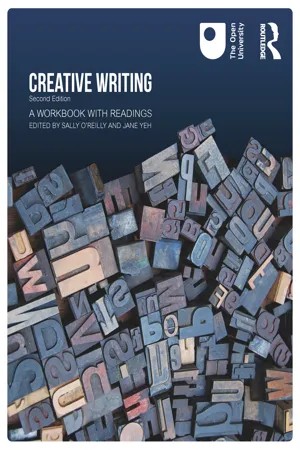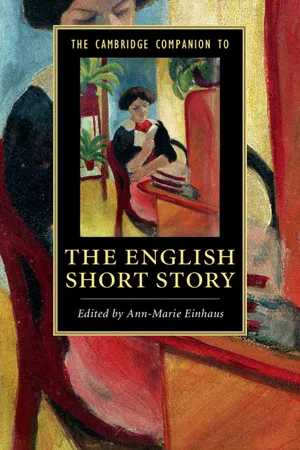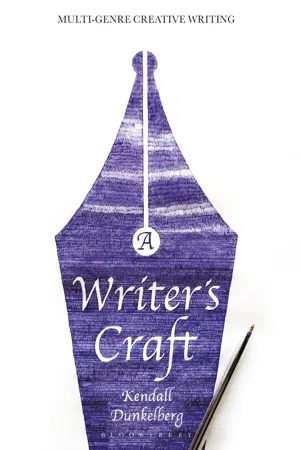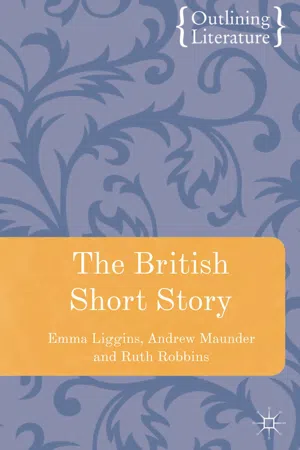Literature
Flash Fiction
Flash fiction is a very short form of storytelling characterized by its brevity, typically ranging from 300 to 1000 words. It aims to convey a complete narrative or idea in a compact space, often focusing on a single character or moment. This concise style challenges writers to convey depth and emotion within a limited word count.
Written by Perlego with AI-assistance
Related key terms
1 of 5
12 Key excerpts on "Flash Fiction"
- Joshua Miller(Author)
- 2021(Publication Date)
- Cambridge University Press(Publisher)
Forms 1 ANGELA NAIMOU Short Fiction, Flash Fiction, Microfiction By definition, short fiction does not go on for very long. It could be counted in words, as in Ernest Hemingway’s apocryphal six-word story “For sale: baby shoes, never worn.” 1 Or it could be measured by the sentence, as in Augusto Monterroso’s “El Dinosaurio,” widely regarded as one of the world’s shortest stories: “Cuando despertó, el dinosaurio todavía estaba allí” (“When he/she/it awoke, the dinosaur was still there”). 2 Or in letters and symbols, as in fiction published on Twitter in posts limited to 140 characters. Microfiction has been categorized as fiction less than a hundred words, flash fiction less than 750 words, short-short stories as long as several pages. Words that flash, stories in micro: short fiction forms highlight the relational and seemingly paradoxical experiences of reading as an embodied process in time and space. Short forms have a long history of creating something like a world within a word, or six or seven, a feeling conveyed in the famous slip in a letter from Martha to Henry Bloom: “I called you naughty boy because I do not like that other world.” 3 However defined, shortness is a constraint that may seem inadequate to the complex problems that occupy so much of twenty-first-century fiction. Studies in fiction have tended to center on the novel to track important aesthetic innovations and theorize the relation of fiction to ecological and social time scales so immense they exceed human perception and under- standing. How an artwork may render large scales of time and geopolitical space sensible – or at least, imaginable – to human perception has long been a core aesthetic problem. Contemporary art forms and modes of thought attest to the urgency of identifying the global patterns and practices that nourish or degrade our worlds.- No longer available |Learn more
- Paul Alan Fahey(Author)
- 2016(Publication Date)
- JMS Books LLC(Publisher)
Chapter 2: Flash Fiction
Like all fiction that matters, their success depends not on their length, but on their depth, their clarity of vision, their human significance. —James ThomasFlash Fiction may seem like a relatively new genre, but you may be surprised to learn it’s been around for some time. James Thurber imagined a hung-over Ulysses S. Grant meeting Robert E. Lee at Appomattox and surrendering his sword to the bewildered general from the South. Katherine Anne Porter told a tale of magic about a New Orleans prostitute who rebelled against her abusive madam and left the “house” only to return in a week, meek and mild, after the madam’s cook cast a spell on her.What do these stories have in common? Each one has a length of approximately 1,500 words, and there are many more such pieces, some even shorter, written by Chekhov, Crane, Kafka, Lessing, and De Maupassant. Even Hemingway’s A Very Short Story , weighs in at slightly over 600 words.Reading Flash Fiction or short-shorts of 500 to 1,500 words—some editors extend the word limit to 2,000—is like eating potato chips or for me, cashews. You can’t read just one. You gobble them down, one tantalizing bit after another. Whether they’re called blasters, postcard fiction, micro-fiction, sudden fiction, short-shorts, or Flash Fiction, the essence of the genre is the same. The writer quickly gets into the story, establishes setting and character, sets up the conflict, fills-in critical back story, then heads faster than a speeding bullet toward the climax and resolution.Almost every How To writing text stresses the importance of learning to write cleanly and concisely. Experts tell us to pare down our adjectives and adverbs and shorten lengthy prose by finding just the right words to describe character and setting. As writers, we hone our skills like trained athletes, but instead of setting physical tasks for ourselves, we exercise daily in our journals and notebooks. Through these writing routines, we flesh out characters, try out themes, explore point of view (POV), voice, and often create story drafts in just one sitting. Some of these wonderful gems often lead beyond flash to even lengthier works—short stories and novellas—perfect for publishing in the e-age. - eBook - ePub
Writing Flash
How to Craft and Publish Flash Fiction for a Booming Market
- Fred D. White(Author)
- 2018(Publication Date)
- Quill Driver Books(Publisher)
As with long-form fiction or poetry, Flash Fiction can either be based on traditional models, or it can venture into new modes of storytelling. Because of its brevity, Flash Fiction is an ideal medium for innovation. I myself enjoy working within traditional genres, especially science fiction and fantasy. There is plenty of room, I discovered, for innovation within genres. On occasion, though, I like to experiment with style and structure. I suspect that deep inside every writer is the urge to break free of preconceptions, of conventions. Flash Fiction is a good way to go rogue artistically.In this chapter, I will introduce you to the different varieties of Flash Fiction to give you a sense of the range of its possibilities. In Chapter 3 I will focus on the techniques of analyzing flash stories in each of these categories, because analytical skills are an important means of augmenting creative skills. Then, in Chapters 4 –7 , I will take you through a step-by-step procedure for writing a flash story in each of those categories. Be sure that you complete at least some of the exercises at the end of each chapter. You will then be ready to submit your stories to journal editors for possible publication; Chapters 8 and 9 will show you exactly how to do that.Literary Flash I: Character EmphasisDescribing a story as “literary” means that it is more concerned with conveying subtleties of human behavior in the context of a compelling predicament, employing time-honored literary devices like irony and symbolism—devices, by the way, that poets typically rely on. Indeed, the distinction between literary Flash Fiction and prose poetry is rather blurry.Readers turn to literary fiction to gain insight into, and appreciation of, what it means to be human, how human beings can deal with adversity, how they’re able to cope with the mistakes they’ve made. Literary Flash Fiction is no different, except that it aims to transmit its purpose in no more than 1000 words. It is, quite frankly, a daunting challenge—some might even argue that it’s impossible.The first question that likely springs to mind is, Why not use all the words one can to tell the story? What is so great about restricting the story’s length to a thousand or fewer words? The answer is that the more concentrated something is, the more radiant it can be. Think of the element carbon: one of its manifestations is coal; another, the result of stupendous subterranean pressures, is diamond. A literary flash story dazzles readers with its ability to convey an insight into the human condition with carefully honed language and a limited but precise selection of detail. The trick is to use just enough details to imply - eBook - PDF
- A. Cox(Author)
- 2011(Publication Date)
- Palgrave Macmillan(Publisher)
Thomas proposes that sudden fiction is around 1750 words, while Flash Fiction is approximately 750 words or less (1992: 12). Microfiction is described in one instance as ‘a few hundred words’ (Gessell, 2004) and in another as 500 words (by the literary magazine Prairie Fire). While length is the overriding criterion for labelling a story as a short short, this seems inadequate. As noted by Pratt (1994: 95) when writing about all short stories, ‘The problem with shortness, of course, arises from a sense that literary genres ought to be characterised by aesthetic properties, and shortness seems altogether too quantitative, too material a feature to be given top billing.’ In the case of short shorts, narratives and other stylistic features, such as intertextual referencing, emerge in ways somewhat 14 Teaching the Short Story distinctive to the form. Literary theorists noted this problem of defini- tion before short shorts grew in popularity. One of the stories used in this chapter, Hemingway’s ‘The Revolutionist’, has been referred to as a prose vignette or ‘sketch’ (Scholes, 1985: 41); yet Scholes also recog- nised ‘a little narrative to be constructed from this text’, suggesting that ‘sketch’ is an insufficient term. With consideration to narrative structure and stylistic features sug- gesting one genre or another, these short fictions raise discussion points for classroom activities and essay assignments. For instance, ‘Water’ by Leebron, also in this chapter, has been taught as part of an exercise in questioning generic categories, debating whether the piece is prose, poetry or a prose poem. What can be stated in broad terms about short shorts, however, is that at the surface level, the stories provided to readers are often incomplete or suggestive of a much larger, less anecdotal, story. - David Morley(Author)
- 2007(Publication Date)
- Cambridge University Press(Publisher)
Indeed, the entire action may take place within the space of a page. Think of them as The practice of fiction 157 prose-haiku. The shortest versions are called nanofiction and are popular on internet publishing sites. Despite their experimental brevity, write your story using a protagonist, conflict, obstacles and resolution; even use a beginning, middle and end. Some aspects should be alluded to or implied, like sticky threads thrown wide around your piece in order to capture and reel in external connotations and resonances. This saves words. More than any other type of writing, a short-short should be written and redrafted in one sitting; part of their energy arises from that concentration of nerve. As Don Paterson writes, ‘The shorter the form, the greater our expectation of its significance – and the greater its capacity for disappointing us’ (2004: 189). Flash Fiction is popular with new writers: it makes for immediacy, but can become a displacement activity to avoid longer-haul tasks. Ron Carlson comments, ‘I’m all for short good writing with no sagging in it at all, but I’m also for good long writing with no sagging in it at all . . . the boom in short-shorts has more to do with precious page space than with attention spans . . .’ (Shapard and Thomas, 1989: 312). Carlson has a point. Is brevity a virtue? The various Sudden Fiction anthologies edited by Shapard and Thomas provide models and challenges. Writing Game T H E N O I S E O F S T O R Y Four games in one! Write a short-short using words of one syllable only. Then write a short-short of 400 words, in which every sentence has exactly 8 words. Then write a short-short of 300 words which is entirely one sentence. Write a short story of 2,000 words using no adjectives or adverbs and which can only be understood clearly when it is read aloud by two disembodied voices. A I M : Professional oral storytellers vary the speed and rhythm of their voices to capture and maintain our attention.- Tamara Girardi, Abigail G. Scheg, Tamara Girardi, Abigail G. Scheg(Authors)
- 2021(Publication Date)
- Routledge(Publisher)
Free Press Journal article shines light on what it really means to comprise a well-constructed piece of flash:While novelists have hundreds of pages in which to build a plot and develop character relationships, flash authors use strict decision-making skills to fit those elements into “the shortest span.”The operative words for the genre are short and snappy, and getting it right is no mean job. The writing … banks entirely on the element of appeal in the shortest span of time and the choice of the most appropriate set of words, of course, without the loss of emotion and essence.(2018)In a world where Twitter is king and your average reader is hit with short bursts of text, both for informational and entertainment purposes, it is no surprise that literature is following suit. Of course, people still read and write novels, but the fact that extremely short stories are gaining prevalence is no coincidence. This is neither positive, nor negative; it just is.What is positive about this movement, however, is that authors specializing in flash master some of the most difficult authorial responsibilities that writers face. Due to the shortened nature of these texts authors must capture brevity, causing them to get to the heart of their story, and stay there. In this genre, there is no room for extraneous language or story elements. Everything a flash writer uses is necessary and serves a purpose. This gives the writing a raw, authentic feeling that people get during real life experiences. Much like other societal trends requiring immediate satisfaction and completion, readers consume these stories within minutes. Whereas longer works may take days or more to complete, a reader can finish a piece of flash, analyze it both for content and literary breakdown, and consider how these elements can be applied in one’s own writing, all during one sitting. For an online class, Flash Fiction is one way to expose students to a variety of authors and concepts quickly.- eBook - ePub
Short-Form Creative Writing
A Writer's Guide and Anthology
- H. K. Hummel, Stephanie Lenox(Authors)
- 2018(Publication Date)
- Bloomsbury Academic(Publisher)
The experience of readers in the nineteenth century continued to change with periodicals, which could be produced cheaply and distributed efficiently to a more centralized urban readership. These publications gained prominence over the course of this century and provided a venue for short-form writing. Writers of short stories, brief anecdotes, sketches, and tales could sell their stories to periodicals and make a profitable living. Short-form writing has always existed alongside other forms of literature, but it was this period in history that popularized it and also made it profitable for writers. Increased interest in short pieces solidified formal characteristics that emphasized thematic unity and restraint.It wasn’t until the later part of the twentieth century that a tendency toward extremely short stories came to the attention of editors Robert Shapard and James Thomas. In their reading, they noticed works of fiction totaling no more than a few pages in length that seemed to position themselves between the genres of fiction and poetry. These highly compressed narratives took cues from the short story, but they also contained language charged with the lyric intensity of a poem. In the first of a series of anthologies, Shapard and Thomas coined the term for these stories: Flash Fiction. They were not the first to attempt to label these extremely brief stories, and they certainly weren’t the last. In fact, more than any kind of writing, short-form fiction has inspired the most diverse array of appellations, not just in English but in languages from around the globe.The word count for these short forms varies just about as much as the names that have been used to describe them. Yet they all point to a kind of writing that thrives on limits. In his introduction to Flash Fiction: Very Short Stories, James Thomas points to Ernest Hemingway’s “A Very Short Story,” published in 1925, as an archetype of the short form. Thomas used this story to set the limit of 750 words for the stories in his anthology. His editorial partner Robert Shapard, in his series of Sudden Fiction - eBook - ePub
Creative Writing
A Workbook with Readings
- Jane Yeh, Sally O'Reilly, Jane Yeh, Sally O'Reilly(Authors)
- 2022(Publication Date)
- Routledge(Publisher)
One of the biggest decisions to be made about a piece of fiction is how long it should be. Often this decision seems to be made by the subject matter and what you are writing about. As Farhana Shaikh says: ‘Unlike a novel where you have the freedom, both in terms of word length and time, to lay down the foundations of your world and the environment your character inhabits, a short story must achieve this in just a few thousand words’ (2020).For instance, you might imagine a scene — with two people sitting on the shores of a lake. You might be able to picture immediately why the characters have come to the lake, why the surrounding landscape has significance for them, and you might imagine other relevant moments and other characters. Just from one scene you might find you are getting involved in a web of connected elements that can’t be contained in 1000 words: it would seem to demand a longer narrative.Equally possible, you might picture the scene by the lake and not want or be able to do anything more with it. You might want to focus just on that moment and to develop the characters in a more confined way. Some ideas are small and local to their first-found image or character. Their effect isn’t necessarily small or local. They are snapshots, captured moments in time that would lose something if they were elaborated upon. You will be dealing with such snapshots again when you come to the life writing section of this book (Part 4 ).Of course, many brief stories evolve out of large first drafts that are whittled down during the editing process. Short story writing is often an exercise in containing the size and scope, so the final version fits its content and aims, and where relevant, also fits the requirements of possible target publications or competitions.2.1 Flash Fiction, concision and finding the length
Figure 1 A man uses a magnifying glass to examine a micro-sized book (photo: gawrav/Getty Images).The shorter variety of short story is called Flash Fiction - Ann-Marie Einhaus(Author)
- 2016(Publication Date)
- Cambridge University Press(Publisher)
39 What is crucial in both cases is a sense that at the heart of the microfictional enterprise is the question of relation: of works to one another, of works to readers, and finally of readers to one another, as these works collectively address a reading public which is marked by divergent views on the nature, limits, merits and effects of the genre. The rapid proliferation of microfiction as a professional genre – one taught in many creative writing courses, codified in numerous textbooks, published in lucrative literary journals and magazines, the subject of international writ- ing competitions and festivals such as the United Kingdom’s National Flash Fiction Day, and embedded within an ever-proliferating number of online platforms – has meant that a great number of its best works have been writ- ten with a specific set of relations in mind. Such relations often involve revis- iting historical forms, as exemplified in Borges’ or Carter’s use of folklore and fable. Equally prominent are the intertextual relations commonly used by writers of microfiction to ‘increase the function or interpretive reach of a story’. 40 Consider, for example, Teju Cole’s Twitter fictions, Seven Short Stories about Drones (2013), 41 a series of short tweets, each of which begins with the opening line of a celebrated novel, followed by an incisive phrase carefully conceived to convey the brutal futility of drone warfare. Particularly significant are the increasingly numerous longer cycles from leading authors which demonstrate both continuity and diversity. Jim Crace’s The Devil’s Larder (2002) is one of several compelling microfictional Marc Botha 210 cycles – others include Stein’s Tender Buttons, Carter’s The Bloody Chamber (1979), Alasdair Gray’s Lean Tales (1985), Robert Olen Butler’s Severance (2006) and Jonathan Kemp’s Twentysix (2006) – which weave together dis- tinct miniature narratives by shared threads of motif, theme, style or formal constraint.- eBook - ePub
A Writer's Craft
Multi-Genre Creative Writing
- Kendall Dunkelberg(Author)
- 2017(Publication Date)
- Bloomsbury Academic(Publisher)
12FictionWhat Is Fiction?On the one hand, this may be the easiest genre to define. Most of us are more familiar with fiction than with the other genres. We read novels from the time we begin to read. Accelerated reader programs in public schools rely primarily on novels and some nonfiction, but rarely include poetry or drama. It’s likely you’ve read more fiction than just about any other form, except perhaps textbooks. To define it, we might call it a form that tells an invented story using prose. That doesn’t get us too far, though, and once you start looking at the form in more detail, there’s still plenty to learn.One distinction I like to make about fiction for the undergraduate creative writing classroom, at least at the introductory level, is that we typically focus on the short story, rather than the novel, which is the most familiar. It is worth thinking for a moment about the differences between the novel and the short story forms. Obviously, the main difference is that one is much shorter than the other, but what does that mean for the short story writer?In a novel, you have anywhere from 200 to 1,000 pages (or more) to tell your story. In a short story, you have anywhere from 4 pages to 40. Any longer, and you have a novella. Any shorter, and what you are writing is probably Flash Fiction. Fiction can be any length, but how you set about telling your story will depend on what length you are shooting for, and for the beginning short story writer, this is often one of the biggest challenges. If you are shooting for 7 to 15 pages (a reasonable length for a story, especially if you are also working on other genres), then you really only have room to develop a few scenes. Everything has to be focused around a few central moments, and you have to find a way to reveal essential background details that help us understand those moments without overburdening the story with a lot of scene. - eBook - PDF
The Modernist Short Story
A Study in Theory and Practice
- Dominic Head(Author)
- 2009(Publication Date)
- Cambridge University Press(Publisher)
Indeed, she begins her article by asserting that 'when the history of the modern short story is written it will have to take account' of these 'two related developments'. 52 As if in response to this assertion Clare Hanson has structured her history of the short form, Short Stories and Short Fictions: i88o-ig8o, to set the two The short story: theories and definitions i7 trends in opposition. She has even posited a new terminology to distinguish between short stories — the conventional, epical, plot- based type - and short fictions in which plot is subordinate to internal psychological drama, a category that roughly equates with Baldeshwiler's lyrical story, and Ferguson's complex episode. Hanson's chapter on the modernist era locates Joyce, Woolf, and Mansfield within the latter camp, as writers of short fictions rather than stories. 53 The tidiness of this taxonomy is appealing, but when one examines its implications, problems present themselves. To begin with, the term 'short fiction' carries a burden of signification which is not easily cast off: short fiction is frequently used as an imprecise, all-purpose term which subsumes 'sketch', 'story' and 'novella'- any fiction which is not a novel, effectively. The problem with trying to recoup such a generalized term as a specific critical tool is self- evident, and this terminological quibble suggests a larger problem of descriptive accuracy, especially in relation to Hanson's treatment of the modernists. It is true that plot is de- emphasized in the stories of Joyce, Mansfield and Woolf, and this distinguishes their work from the more carefully plotted short fictions of, for example, Henry James and Joseph Conrad. - eBook - PDF
- Emma Liggins, Andrew Maunder, Ruth Robbins(Authors)
- 2017(Publication Date)
- Red Globe Press(Publisher)
1 Introduction: What Is a Short Story? 1 This question has always exercised critics and commentators on the short story, and often involves them in extraordinary contortions to avoid the simplest and most circular answer: a short story is a story – a narrative sequence of events, episodes or connected emotions – which is short. Even if the term ‘story’ is reasonably uncontentious (and frankly it is not entirely agreed upon), shortness introduces an element of relativity which causes major problems for the short-story critic. A short story is short generally in contrast to the longer prose narrative the novel. Ian Reid goes so far as to say that ‘in its current usage “short story” is generally applied to almost any kind of prose narrative briefer than a novel’, and shortness can lead to accusations of ‘slightness and slickness’, 1 of lesser status and lesser seriousness than the larger work of prose fiction. Size, apparently, matters. Critics therefore often operate by analogy with other forms to describe the short story’s special status. As Dominic Head has suggested, visual metaphors in particular are fre-quently used, 2 although these have the disadvantage of presuming a specific patterning in short fiction, forgetting that all narrative is essen-tially temporal, understood through time, rather than primarily spatial as visual art is. Thus, Valerie Shaw suggests that the volume of short stories can be usefully likened to an art exhibition, 3 and William Boyd, in a 2004 Guardian article, writes that the short story is comparable to an exquisite miniature painting, ‘art in highly concentrated form’, whose effects are akin to those of the multivitamin pill: ‘a compressed blast of discerning, intellectual pleasure’. 4 Or the critic turns to meta-phors derived from poetry: the short story is to the novel what the lyric is to the epic – the first is personal, compressed, fragmented and emo-tional, and the second is universal, expansive, totalising and objective.
Index pages curate the most relevant extracts from our library of academic textbooks. They’ve been created using an in-house natural language model (NLM), each adding context and meaning to key research topics.

